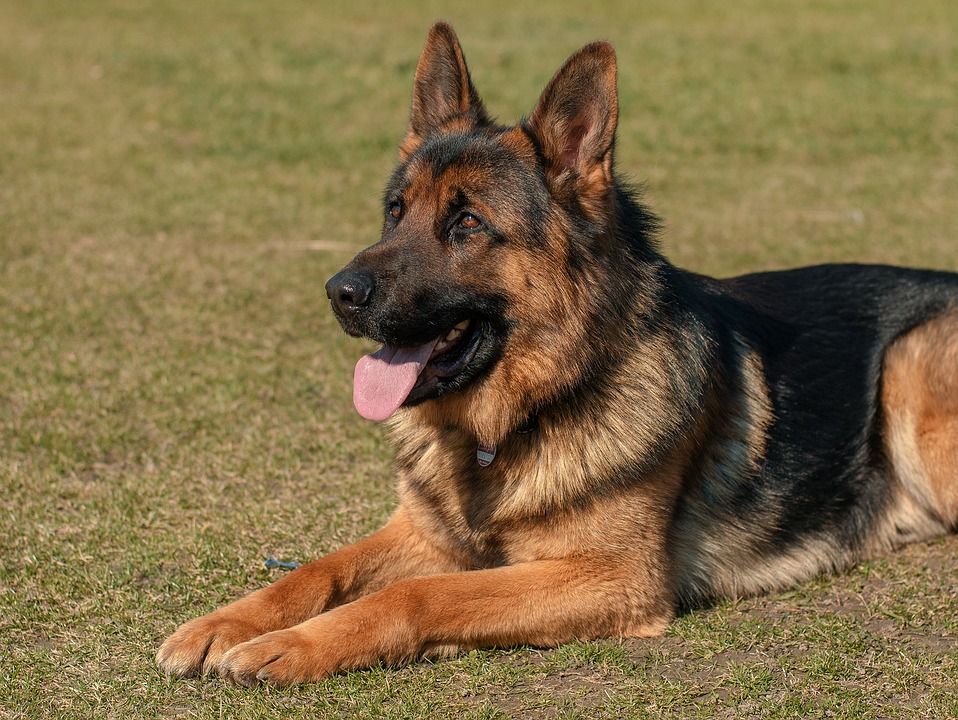The German Shepherd
Vital Stats of German Shepherds
The following are vital stats of German Shepherds:
- Dog breed group: Herding
- Height: 22 to 26 inches at the shoulder
- Weight: 50 to 90 pounds
- Lifespan: 10 to 13 years
Physical Characteristics of German Shepherds

The German Shepherd has a double coat. This coat consists of a thick undercoat and a dense, slightly wavy or straight outer coat. Typically, his hair is tan and black, or red and black in color, is medium in length and sheds all year round. Other, more rare color variations include all-black, all-white, liver and blue.
In addition, this breed has a long body, usually between 22 and 26 inches — in proportion to its height. Therefore, this gives the dog strength, agility, elasticity and long, elegant strides.
The German Shepherd’s Personality
Ideally, German Shepherds are direct, fearless and confident. When he comes from parents who have good temperaments and has been socialized to become familiar with many different people, sights and sounds, he is is an intelligent, easy to train, devoted, protective and fun-loving companion.
Naturally protective of his home and property, the German Shepherd will always alert you to strangers or intruders. However, if you welcome someone into your home, your German Shepherd will accept them, too. In addition, he will get along with other pets, particularly if he is around them from puppyhood. This breed is smart and learns quickly that cats rule!
This breed needs a job. Many German Shepherds are raised successfully in kennel situations. However, these are working dogs who have demanding and interesting tasks to do that give them the necessary exercise and mental stimulation.
Care for German Shepherds

While this breed can live outdoors in cool or temperate climates, he enjoys living indoors too. Also, frequent training and exercise sessions are necessary for keeping his mind and body active.
In addition, because the German Shepherds sheds throughout the year, his coat requires brushing once or twice a week to encourage turnover as well as to minimize buildup in the home.
Health of German Shepherds
Similar to any breed, the German Shepherd is susceptible to some serious health conditions. These include elbow dysplasia and canine hip dysplasia (CHD), as well as minor problems like the following:
- cardiomyopathy
- hemangiosarcoma
- panosteitis
- von Willebrand’s Disease (vWD)
- degenerative myelopath
- , cauda equina
- malignant neoplasums, pannus
- hot spots
- skin allergies
- gastric torsion
- cataract
- perianal fistulas
History of German Shepherds
As the name suggests, the German Shepherd originated in Germany. He was created in the nineteenth century primarily by Captain Max von Stephanitz, who wanted to develop a dog that could be used for military and police work. The result was a dog that encompassed striking good looks, intelligence and versatility.
The German Shepherd, being an adaptable and attractive breed, soon drew the attention of dog lovers in other countries. Rin Tin Tin is the most famous of the German Shepherds, but he was not the first to come to the U.S. It is known to have been brought to the U.S. in 1906. Also, the American Kennel Club registered a German Shepherd in 1912. The following year the German Shepherd Dog Club of America was formed by people interested in the breed.
For more information on the German Shepherd or other dog breeds, don’t hesitate to contact us here at All Pets Veterinary Medical Center with the link below!
















